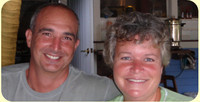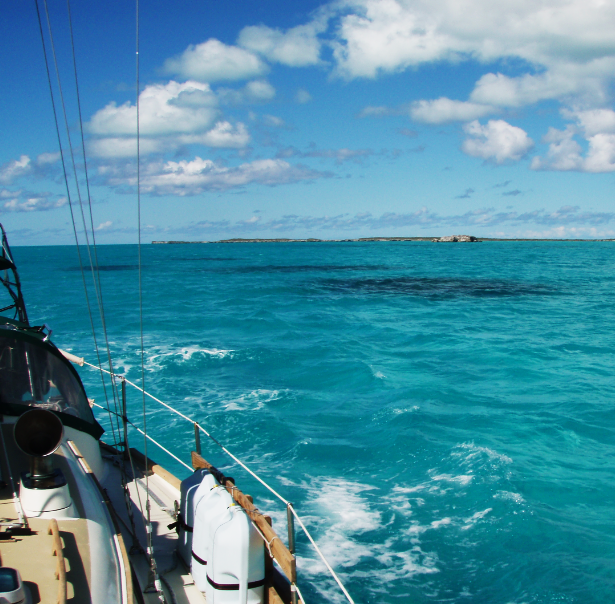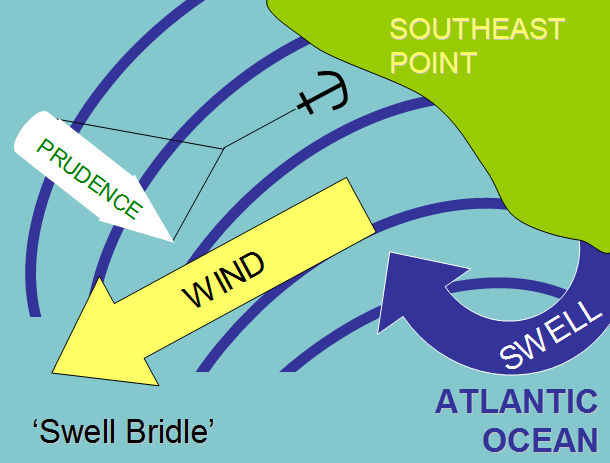

- PHOTOS:
- Dec 16, 2008 - May 21, 2009
- Mar 17, 2008 - Dec 15, 2008
- Nov 01, 2007 - Mar 16, 2008
- Our SC35 Sailboat: PRUDENCE
- SELECTED BLOGS
- Jan'05: The Idea
- May'05: First Cruise - Belize
- Aug'05: Buying Ashiya
- Oct'05: School in St. Vincent
- Nov'05: Ocracoke on Ashiya
- Jul'06: Long Trip on Ashiya
- Oct'06: Prudence Comes Home
- Nov'07: First Night Offshore
- Nov'07: Offshore Take Two
- Nov'07: Gulf Stream Crossing
- Dec'07: Green Turtle Cay
- Dec'07: Lynyard Cay
- Dec'07: Warderick Wells Cay
- Jan'08: George Town
- Jan'08: Life without a Fridge
- Jan'08: Mayaguana Island
- Jan'08: Turks & Caicos
- Jan'08: Dominican Republic
- Jan'08: Down the Waterfalls
- Feb'08: Puerto Rico
- Feb'08: Starter Troubles
- Feb'08: Vieques
- Mar'08: Finally Sailing Again
- Mar'08: Trip So Far
- Mar'08: Hiking Culebra
- Mar'08: Kayak & Snorkel I
- Mar'08: Teak and Waterspouts
- Mar'08: Kayak & Snorkel II
- Mar'08: Bottom Cleaning
- Apr'08: Culebra Social Life
- Apr'08: Culebra Routine
- Apr'08: Culebra Beaches
- Apr'08: Culebrita
- Jun'08: Kayak & Snorkel III
- Jun'08: Kayak & Snorkel IV
- Jun'08: Manta Ray
- Jun'08: Sea Turtles
- Jul'08: Cost of Cruising
- Jul'08: Busy Week in Culebra
- Jul'08: Getting to Land
- Jul'08: Leatherback Boil
- Jul'08: Fish and Volcano Dust
- Aug'08: Teaching Algebra
- Sep'08: Culebra Card Club
- Oct'08: Kayak & Snorkel V
- Oct'08: Prep for Hurricane
- Oct'08: Hurricane Omar
- Oct'08: Fish and Sea Glass
- Oct'08: Waterspouts
- Dec'08: Hurricane Season Ends
- Dec'08: Culebra to St. Martin
- Jan'09: Antigua Part 1
- Feb'09: The Saints
- Feb'09: Visiting Dominica
- Mar'09: Antigua Part 2
- Apr'09: Antigua to Bermuda
- May'09: Bermuda to Norfolk
- FULL LIST of Blog Entries
15 July 2009
14 July 2009
15 June 2009
14 June 2009 | Annapolis, MD
13 June 2009
12 June 2009
11 June 2009
10 June 2009 | Little Creek Marina, Norfolk, VA, USA
04 June 2009 | Little Creek Marina, Norfolk, VA, USA
31 May 2009 | Little Creek Marina, Norfolk, VA, USA
29 May 2009 | Little Creek Marina, Norfolk, VA, USA
26 May 2009 | Little Creek Marina, Norfolk, VA, USA
25 May 2009 | Little Creek Marina, Norfolk, VA, USA
13 May 2009 | through 21-May-2009
13 May 2009 | through 21-May-2009
12 May 2009 | St George's Town, Bermuda
11 May 2009 | St George's Town, Bermuda
07 May 2009 | St George's Town, Bermuda
04 May 2009 | St George's Town, Bermuda
21 April 2009 | through 02-May-2009
Sailing to Another Country
16 January 2008 | From Mayaguana Island, Bahamas to Providenciales, Turks & Caicos

CURRENT LOCATION: Anchored in Sapodilla Bay off the island of Providenciales (commonly called Provo) in the Turks & Caicos
21 44.728' N, 072 17.389' W
Sometime after dark, while anchored at Mayaguana, winds returned out of the east. Our anchorage gave good protection from these east winds, but ocean swell wrapped around the corner of the island and caught Prudence on the beam. By 8PM (two hours after we had turned in), the boat was rolling uncomfortably.
I decided to try employing a corrective action I had read about in a book, a swell bridle. I got out a long dockline, attached it to a point on the chain about 20-feet out from the bow and lead it back to the cockpit. We have a block near the rear of the boat which is used when flying our assymetrical spinnaker, so I led the line through that block and around the winch. I cranked in until the stern of the boat was pulled around such that our bow faced into the swell. Immediately, the rolling motion subsided. This swell bridle is a pretty good trick. And the name is quite suitable, because it really is a swell thing, indeed.

With the swell bridle in place, this would have been a great anchorage to spend the entire night; however, we planned a morning landfall in the Turks & Caicos, so only a few short hours after I deployed the bridle, it was removed. I hauled in the remainder of the anchor rode (not such a simple task when it is dark, the anchor is 30 feet down, and the boat is rolling from side to side), and Sheryl motored us out into the Atlantic. It was midnight and the moonlight lit our path to the southeast.
Even though we noted the east winds, at anchor we didn't think there would be enough to sail upon. Within minutes of clearing the tip of the island, though, we were happy to find 12-15 knots of wind at an angle which would provide us a close reach directly along our rhum line. We sailed along at about 5 knots, in no real hurry because we did not want to come up upon the Caicos Bank until late morning.
Our path across the Caicos Bank to Provo would take us through the Sandbore Channel. This channel is a half-mile wide and easy to approach and transit from the ocean. Unfortunately, though, once up on the bank the path is littered with coral heads and these potentially keel-damaging obstacles are not accurately charted here in the Turks & Caicos. We needed to wait until late morning to have good sunlight showing these dangers zones so that we could steer a course around them.
As we approached the bank we shortened sail to slow the boat; otherwise we would have arrived too early. Just outside the mouth of the Sandbore Channel, a pod of dolphins arrived and helped us occupy the final hour of our offshore stall. It has been far too long since we have seen these good luck omens playing off our bow.
By 10AM the lighting was right so we said goodbye to our dolphin friends, doused our sails and motored eastward, directly into the wind and up onto the bank. The depth below our keel changed from over a 1000 meters to 4 meters in mere moments. With even more shoal waters and coral ahead, it was time to start bow watch.
Sheryl stood at the bow and I took the helm. We had prearranged a series of hand signals to facilitate communication. I would steer the rhum line course to our destination, while Sheryl kept an eye out for coral. [NOTE: The coral appears as dark patches when lit by overhead sunlight. Notice the spots of coral we had just passed off to our port in the lead photo above.] Whenever she spotted a patch, Sheryl would signal for me to adjust course around the danger. During those periods, for all intents and purposes, Sheryl was driving the boat from the bow by merely waving her hands.
We made it to Sapodilla Bay without incident and dropped the hook near several boats we recognized from George Town. Once the dinghy was inflated, Sheryl went in to Provo in order to officially clear us in to this new country while I stayed aboard to make sure the anchor was holding firmly.
Generally, when one of us is off the boat without the other, the noise of our 2-stroke Evinrude announces their return. Therefore, it is customary to greet the returning dinghy voyager and take their line. Sheryl was a little concerned upon returning from the customs office when I did not come up on deck. She quickly realized that I had fallen asleep below. Not the most efficient way to conduct anchor watch, I know, but fatigue had taken over before I was even aware of it. I hadn't tried to take a nap, rather I simply passed out.
Sheryl suggested that we try to maintain consciousness until dark, just to get our bodies back on some sort of a normal sleep cycle. I agreed; therefore, we took down our "Q" flag and raised the British ensign (our courtesy flag for Turk & Caicos), we enjoyed dinner, and we talked a little about our plans for our short stay here in this country. Soon darkness was upon us and sleep (8-10 uninterrupted hours of glorious sleep) was upon us.
21 44.728' N, 072 17.389' W
Sometime after dark, while anchored at Mayaguana, winds returned out of the east. Our anchorage gave good protection from these east winds, but ocean swell wrapped around the corner of the island and caught Prudence on the beam. By 8PM (two hours after we had turned in), the boat was rolling uncomfortably.
I decided to try employing a corrective action I had read about in a book, a swell bridle. I got out a long dockline, attached it to a point on the chain about 20-feet out from the bow and lead it back to the cockpit. We have a block near the rear of the boat which is used when flying our assymetrical spinnaker, so I led the line through that block and around the winch. I cranked in until the stern of the boat was pulled around such that our bow faced into the swell. Immediately, the rolling motion subsided. This swell bridle is a pretty good trick. And the name is quite suitable, because it really is a swell thing, indeed.

With the swell bridle in place, this would have been a great anchorage to spend the entire night; however, we planned a morning landfall in the Turks & Caicos, so only a few short hours after I deployed the bridle, it was removed. I hauled in the remainder of the anchor rode (not such a simple task when it is dark, the anchor is 30 feet down, and the boat is rolling from side to side), and Sheryl motored us out into the Atlantic. It was midnight and the moonlight lit our path to the southeast.
Even though we noted the east winds, at anchor we didn't think there would be enough to sail upon. Within minutes of clearing the tip of the island, though, we were happy to find 12-15 knots of wind at an angle which would provide us a close reach directly along our rhum line. We sailed along at about 5 knots, in no real hurry because we did not want to come up upon the Caicos Bank until late morning.
Our path across the Caicos Bank to Provo would take us through the Sandbore Channel. This channel is a half-mile wide and easy to approach and transit from the ocean. Unfortunately, though, once up on the bank the path is littered with coral heads and these potentially keel-damaging obstacles are not accurately charted here in the Turks & Caicos. We needed to wait until late morning to have good sunlight showing these dangers zones so that we could steer a course around them.
As we approached the bank we shortened sail to slow the boat; otherwise we would have arrived too early. Just outside the mouth of the Sandbore Channel, a pod of dolphins arrived and helped us occupy the final hour of our offshore stall. It has been far too long since we have seen these good luck omens playing off our bow.
By 10AM the lighting was right so we said goodbye to our dolphin friends, doused our sails and motored eastward, directly into the wind and up onto the bank. The depth below our keel changed from over a 1000 meters to 4 meters in mere moments. With even more shoal waters and coral ahead, it was time to start bow watch.
Sheryl stood at the bow and I took the helm. We had prearranged a series of hand signals to facilitate communication. I would steer the rhum line course to our destination, while Sheryl kept an eye out for coral. [NOTE: The coral appears as dark patches when lit by overhead sunlight. Notice the spots of coral we had just passed off to our port in the lead photo above.] Whenever she spotted a patch, Sheryl would signal for me to adjust course around the danger. During those periods, for all intents and purposes, Sheryl was driving the boat from the bow by merely waving her hands.
We made it to Sapodilla Bay without incident and dropped the hook near several boats we recognized from George Town. Once the dinghy was inflated, Sheryl went in to Provo in order to officially clear us in to this new country while I stayed aboard to make sure the anchor was holding firmly.
Generally, when one of us is off the boat without the other, the noise of our 2-stroke Evinrude announces their return. Therefore, it is customary to greet the returning dinghy voyager and take their line. Sheryl was a little concerned upon returning from the customs office when I did not come up on deck. She quickly realized that I had fallen asleep below. Not the most efficient way to conduct anchor watch, I know, but fatigue had taken over before I was even aware of it. I hadn't tried to take a nap, rather I simply passed out.
Sheryl suggested that we try to maintain consciousness until dark, just to get our bodies back on some sort of a normal sleep cycle. I agreed; therefore, we took down our "Q" flag and raised the British ensign (our courtesy flag for Turk & Caicos), we enjoyed dinner, and we talked a little about our plans for our short stay here in this country. Soon darkness was upon us and sleep (8-10 uninterrupted hours of glorious sleep) was upon us.
| Vessel Name: | Prudence |
| About: |
Gallery not available

- PHOTOS:
- Dec 16, 2008 - May 21, 2009
- Mar 17, 2008 - Dec 15, 2008
- Nov 01, 2007 - Mar 16, 2008
- Our SC35 Sailboat: PRUDENCE
- SELECTED BLOGS
- Jan'05: The Idea
- May'05: First Cruise - Belize
- Aug'05: Buying Ashiya
- Oct'05: School in St. Vincent
- Nov'05: Ocracoke on Ashiya
- Jul'06: Long Trip on Ashiya
- Oct'06: Prudence Comes Home
- Nov'07: First Night Offshore
- Nov'07: Offshore Take Two
- Nov'07: Gulf Stream Crossing
- Dec'07: Green Turtle Cay
- Dec'07: Lynyard Cay
- Dec'07: Warderick Wells Cay
- Jan'08: George Town
- Jan'08: Life without a Fridge
- Jan'08: Mayaguana Island
- Jan'08: Turks & Caicos
- Jan'08: Dominican Republic
- Jan'08: Down the Waterfalls
- Feb'08: Puerto Rico
- Feb'08: Starter Troubles
- Feb'08: Vieques
- Mar'08: Finally Sailing Again
- Mar'08: Trip So Far
- Mar'08: Hiking Culebra
- Mar'08: Kayak & Snorkel I
- Mar'08: Teak and Waterspouts
- Mar'08: Kayak & Snorkel II
- Mar'08: Bottom Cleaning
- Apr'08: Culebra Social Life
- Apr'08: Culebra Routine
- Apr'08: Culebra Beaches
- Apr'08: Culebrita
- Jun'08: Kayak & Snorkel III
- Jun'08: Kayak & Snorkel IV
- Jun'08: Manta Ray
- Jun'08: Sea Turtles
- Jul'08: Cost of Cruising
- Jul'08: Busy Week in Culebra
- Jul'08: Getting to Land
- Jul'08: Leatherback Boil
- Jul'08: Fish and Volcano Dust
- Aug'08: Teaching Algebra
- Sep'08: Culebra Card Club
- Oct'08: Kayak & Snorkel V
- Oct'08: Prep for Hurricane
- Oct'08: Hurricane Omar
- Oct'08: Fish and Sea Glass
- Oct'08: Waterspouts
- Dec'08: Hurricane Season Ends
- Dec'08: Culebra to St. Martin
- Jan'09: Antigua Part 1
- Feb'09: The Saints
- Feb'09: Visiting Dominica
- Mar'09: Antigua Part 2
- Apr'09: Antigua to Bermuda
- May'09: Bermuda to Norfolk
- FULL LIST of Blog Entries





